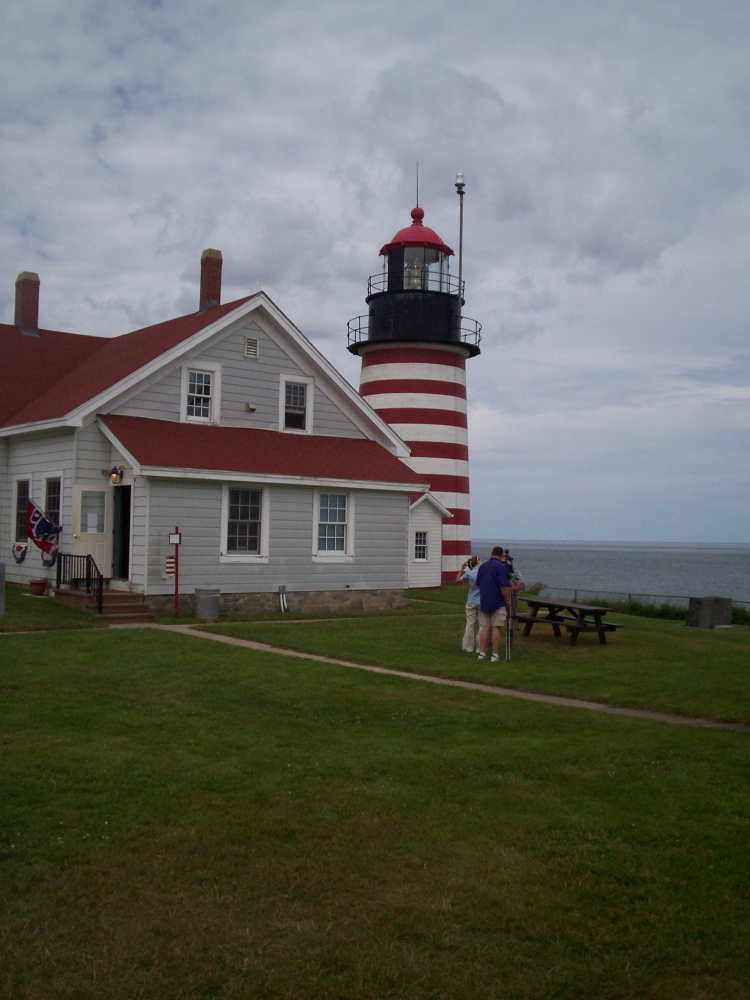What is it about lighthouses that so captures our imagination and makes these iconic coastal structures so alluring? Perhaps it’s the romanticism of sailing vessels of old being guided into port amid dangerous and deadly shoals. Or the image of the self-reliant light keepers enduring blustery storms on their rocky and isolated outposts, keeping their signals lit to ensure the safety of passing boats.
I suspect, more than anything else, it’s just the sheer beauty of both the variety of the structures and the spectacular locations where they were strategically located. To be seen from the sea, these lifesavers needed to be sited on highly visible promontories and rocky outcroppings, hence the breathtaking vistas offered by most of the nearly 70 such beacons that still stand as dependable guardians along our 1,000-mile coastline from New Hampshire to New Brunswick.
It seems as if there’s been a resurgence of public interest in lighthouse in recent years, while at the same time most of the beacons that remain in service have been automated, eliminating the need for full-time keepers. Many have been turned over to private organizations whose mission it is to not only maintain them but to render them available to visitors. And some are in the hands of individual owners who were able, and prescient and lucky enough, to purchase them when the Coast Guard would occasionally put them up for sale.
I remember making a bid for the lighthouse at the end of the 0.8 mile-long breakwater guarding the entrance to Rockland Harbor nearly 50 years ago. My bid of $1,000 was insufficient, apparently, as were all the other bids at the time, which, in retrospect, is fortunate, as that special beacon is now owned by Rockland and leased to the Friends of the Rockland Breakwater, a chapter of the American Lighthouse Foundation.
Since 1990 the lighthouse, which was automated in 1964, has seen a complete renovation, and even contains a small gift shop managed by the Friends. For the perfect photo op, consider taking one of the several daily ferry trips to North Haven or Vinalhaven leaving from the terminal in Rockland and passing within a few feet of the end of the breakwater.
And speaking of Rockland, that’s where you’ll find the most complete collection of lighthouse memorabilia and artifacts, not to mention facts about U.S. lighthouses at the Maine Lighthouse Museum at One Park Drive (the same building as the Chamber of Commerce) on the waterfront.
The highlight of the museum is its one-of-a-kind collection of Fresnel lenses that astounds visitors. These brightly polished gems remind the viewer of the role lighthouses play in the world of maritime safety, not only for commercial activity but for recreational boaters.
Picking my favorites among the vast array of lighthouses along our coast is tough, but here’s my shot at three of my top choices, in no particular order. They are influenced in part by ease of access and the beautiful surroundings, in addition to the charm of the facilities themselves:
MARSHALL POINT LIGHT
Marking the eastern side of the south entrance to Port Clyde Harbor, the 20-foot high rubblestone structure is distinguished by its wooden walkway connecting the light to the mainland. Made famous in a scene from “Forrest Gump,” it’s an easily accessed and striking example of Maine’s enduring lighthouse tradition, made even better by the Marshall Point Lighthouse Museum located in the restored keeper’s house.
BASS HARBOR LIGHT
This light, scenically situated at the southwestern point of Mt. Desert Island, was built in 1858 to warn mariners of the Bass Harbor Bar at the eastern entrance to the harbor, which is also where sailors enter Blue Hill Bay. The brick lighthouse is attached to a 11/2-story keeper’s house, which is not open to the public, but hiking trails around the property abound, leading you right down to boulders on the shore. This oft-photographed lighthouse was chosen by the South Carolina publisher of son Josh’s recent book, “Maine Beer: Brewing in Vacationland,” to adorn its cover.
WEST QUODDY HEAD LIGHT
Standing on a rocky promontory at the very easternmost point in the U.S., this distinctive red and white striped 49-foot brick tower, automated in 1988, sits in Quoddy Head State Park in Lubec. This popular destination is enhanced by the neighboring picnic area and a network of hiking trails along high rocky cliffs. Views to the east of Grand Manan Island in New Brunswick and the real possibility of spotting whales make this destination one to remember.
John Christie is a former ski racer and ski area manager and owner, a ski historian and member of the Maine Ski Hall of Fame. He and his son, Josh, write columns on alternating weeks. He can be reached at:
jchristie@fairpoint.net
Send questions/comments to the editors.



Success. Please wait for the page to reload. If the page does not reload within 5 seconds, please refresh the page.
Enter your email and password to access comments.
Hi, to comment on stories you must . This profile is in addition to your subscription and website login.
Already have a commenting profile? .
Invalid username/password.
Please check your email to confirm and complete your registration.
Only subscribers are eligible to post comments. Please subscribe or login first for digital access. Here’s why.
Use the form below to reset your password. When you've submitted your account email, we will send an email with a reset code.